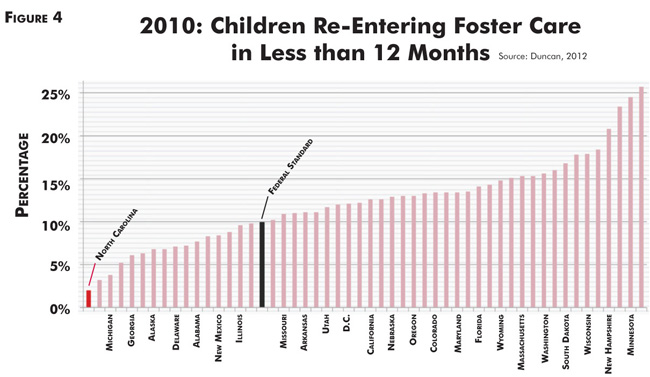 |
 |
 |
Vol.
19, No. 2
March 2014
NC's Performance on Time to Permanence
One way to assess the capacity of our child welfare agencies to work with families and partners in other systems is to look at the speed with which children in foster care achieve permanence through reunification or other means.
How is North Carolina doing in this area? In some ways you might say we are victims of our own success.
Like much of the country, we've changed our way of working over the past 15 years. Today we're placing fewer children in out-of-home care. As a result, there are many fewer children in foster care today than there were in the late 1990s and early 2000s (see Figure 1). That's a good thing, because the families of the children who do enter foster care face complex challenges. Many on the front lines in our state agree that it is harder than it used to be to resolve these families' cases quickly.

We see this reflected in the amount of time kids spend in care. As Figure 2 shows, this is increasing. The median length of stay (LOS) in foster care in North Carolina today is the longest it has ever been: in 2011-12, the most recent year for which we have complete data, the median LOS was 474 days. As Figure 3 shows, North Carolina lags behind in performance on LOS compared to most states.


Clearly, this is an area in which we would like to improve. As Kevin Kelley, Chief of the Child Welfare Services Section in the NC Division of Social Services, states elsewhere in this issue, foster care is supposed to be temporary. Although it mediates safety risks, it cannot give children the permanence they need to develop and thrive.
Our natural response to this information is to look for ways to "pick up the pace" when it comes to finding permanence for children through reunification and other means. This is something we must do.
But in the process we must be careful. For a while now it has been true that when children in North Carolina leave foster care, they are less likely to re-enter care than they are in other states, including states that perform much better than we do on LOS. Figure 4 illustrates this.

Can North Carolina find a way to achieve permanency faster for children in foster care while keeping the rate of re-entry into foster care low?
It is a challenge we are eager to accept. These are measures we will continue to monitor closely.
